
now a Co-cathedral
The diocese of Cervia was a Roman Catholic diocese in Emilia-Romagna. [1] The diocese was a suffragan of the Archdiocese of Ravenna. In 1947, it merged with the archdiocese of Ravenna to form the Archdiocese of Ravenna-Cervia. [1]

The diocese of Cervia was a Roman Catholic diocese in Emilia-Romagna. [1] The diocese was a suffragan of the Archdiocese of Ravenna. In 1947, it merged with the archdiocese of Ravenna to form the Archdiocese of Ravenna-Cervia. [1]
Cervia is a city in the province of Ravenna, Italy, on the ancient Via Flaminia 26.0 km (16.2 mi) south-southeast of Ravenna, in a marshy district near the Adriatic Sea. The town and the diocese were originally called Ficocle (or FIcoclia). In the middle of the 4th century the name was changed to Cervia, though the bishops regularly continued to use the old name. [2] The diocese was a suffragan of Ravenna, according to a document of Pope Gregory I (590–604) now regarded as spurious. It was actually directly subject to the papacy. [3] Pope Agapitus II, in October 948, made Cervia a suffragan of Ravenna. [4] That suffragan status was confirmed by Pope Calixtus II on 7 January 1121, in the bull "Etsi Universae". [5]
The first known Bishop of Cervia was Gerontius. According to his legend, [6] he was returning with Viticanus, Bishop of Cagli, from the Roman council held in 501 to treat accusations made against Pope Symmachus, when he was assaulted and killed by bandits. The legend says "heretics", perhaps Goths, or more probably Heruli, of the army of Odoacer. His remains are preserved at Cagli. He is venerated as a martyr, and is commemorated in the liturgical calendar on May 9.
In 708, the city of Cagli was destroyed by a fire. It was slowly rebuilt. [7]
According to Bonizo of Sutri, a bishop of Cervia participated in the enthronement of the Antipope Clement III (Wibert, Archbishop of Ravenna) in the Lateran Basilica in Rome on 28 June 1083: "a Mutinensie episcopo et a Bononiensi episcopo et a Cerviensis." [8] The manuscript reading, however, is Cueniensi. No other author names a bishop of Cervia. Gebhard of Salzburg names only two bishops; [9] likewise, Bernoldus of Konstanz. [10]
During the episcopate of Bishop Rusticus (1219), in 1224 Cervia was placed under an interdict for its maltreatment of a certain Gerardus, an envoy of the Archbishop of Ravenna. They also abused a procurator of bishop Egidio of Forlimpopoli, who had been sent to announce the interdict. [11]
Other bishops worth mention were: Bishop Joannes (c. 858–881), who was sent on a diplomatic mission by Pope Nicholas I to the court of King Lothair II of Lotharingia; [12] the Venetian Pietro Barbo (1440), later Pope Paul II; Alfonso Visconti (1591–1601), who had been nuncio to the emperor (1589–1591) and to Transylvania (1595–1596); [13] and Bonifacio Bevilacqua (1601–1627), [14] named a Cardinal by Pope Clement VIII on 3 March 1599, and a friend of Pope Gregory XV (Ludovisi), who made him Duke of Fornano.
In 1484, the town of Cervia was destroyed by an earthquake. The Major Council of Ravenna discussed rebuilding the town. [15]
Bishop Ottavio Santacroce (1576–1581) held a diocesan synod in 1577. [16]
On 16 June 1641, Cervia was heavily damaged by a major earthquake. In expiation, the bishop and magistrates instituted an annual procession from the city to Santa Maria del Pino, bearing the remains of the martyr S. Rogatus. [17]
In 1766, the city of Cervia, which was subject to the civil jurisdiction of the papacy in the legation of the Romandiola, contained around 800 persons. [18]
The cathedral of Cervia was dedicated to the taking up of the body (Assumption) of the Virgin Mary into heaven. It was administered and staffed by a corporation called the Chapter, consisting of two dignities (the Archdeacon and the Provost) and eight canons. [19]
In the 19th century, the diocese was composed of only 12 parishes, the entire city of Cervia composing one of those parishes. [20]
On 22 February 1947, the diocese of Cervia was suppressed, and its territory incorporated into the archdiocese of Ravenna. [21]
Erected: 6th Century
Metropolitan: Archdiocese of Ravenna

The Archdiocese of Ancona–Osimo is a Latin Church ecclesiastical territory and metropolitan see of the Catholic Church in the Marche region of Italy.

The Diocese of Nola is a Latin diocese of the Catholic Church in Italy, suffragan of the Archdiocese of Naples. Its seat is the Campanian city of Nola, now a suburb of Naples. Its cathedral is dedicated to the Assumption. The dedication was originally to S. Stephen, the Protomartyr, but after the second reconstruction the dedication was changed to the Assumption. It is traditionally credited with the introduction of the use of bells into Christian worship.

The Diocese of Adria-Rovigo is a Latin diocese of the Catholic Church in the Triveneto. It has existed under this name since 1986. It is a Latin suffragan to the Patriarchate of Venice.

The Diocese of Rimini is a Latin Church ecclesiastical territory or diocese of the Catholic Church in Emilia Romagna, Italy. From earliest times, it was a suffragan to the Holy See, despite repeated attempts by the Diocese of Ravenna to claim it as a suffragan diocese. Since 1604, however, it has been a suffragan of the Archdiocese of Ravenna-Cervia.

The Roman Catholic diocese of Ferentino existed until 1986, when it was united into the new diocese of Frosinone-Veroli-Ferentino.
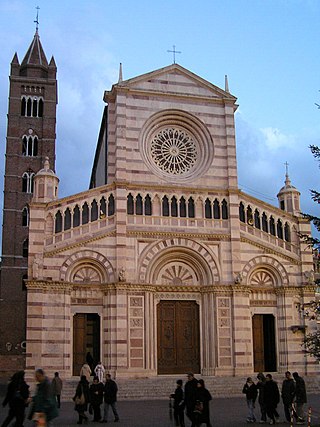
The Diocese of Grosseto is a Latin Church diocese of the Catholic Church in Italy, a suffragan of the archdiocese of Siena-Colle di Val d'Elsa-Montalcino, in Tuscany. Its current bishop is Giovanni Roncari, OFMCap.

The Diocese of Volterra is a Latin diocese of the Catholic Church in Tuscany, central Italy. It is a suffragan of the Archdiocese of Pisa.

The Archdiocese of Lecce is a Latin Church ecclesiastical territory or archdiocese of the Catholic Church in Apulia, southern Italy. The diocese has existed since the 11th century. On 28 September 1960, in the bull Cum a nobis, Pope John XXIII separated the diocese of Lecce from the ecclesiastical province of Otranto and made it directly subject to the Holy See. In the bull Conferentia Episcopalis Apuliae issued on 20 October 1980, Pope John Paul II created the ecclesiastical province of Lecce, with the Archdiocese of Otranto becoming a suffragan diocese.
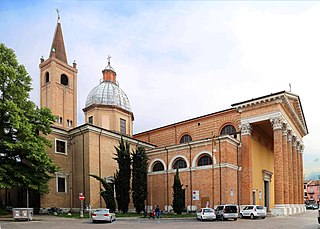
The Diocese of Forlì-Bertinoro is a Latin diocese of the Catholic Church in Romagna, Italy. Until 1986 it was known as the Diocese of Forlì, in existence perhaps from the fourth century. In that year the Diocese of Bertinoro was united to it. The diocese is suffragan to the Archdiocese of Ravenna-Cervia.
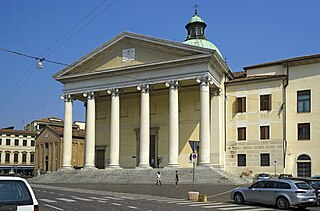
The Diocese of Treviso is Latin Church ecclesiastical territory or diocese of the Catholic Church in the Veneto, Italy. It is a suffragan diocese in the ecclesiastical province of the metropolitan Patriarchate of Venice.
The Catholic diocese of Sarsina was a Roman Catholic ecclesiastical territory in Emilia-Romagna, northern Italy, seated in Sarsina, in the province of Forlì, some 32 km south-southwest of Cesena. The diocese was founded in the 5th century, and was suffragan (subordinate) to the archbishop of Ravenna. The diocese existed until 1986, when it was united with the diocese of Cesena.

The Diocese of Cesena-Sarsina is a Latin diocese of the Catholic Church in Emilia Romagna was created on September 30, 1986, after the Diocese of Sarsina was united with the historic Diocese of Cesena as a suffragan of the Archdiocese of Ravenna-Cervia.

The Diocese of San Severo is a Latin diocese of the Catholic Church in Apulia. It is a suffragan of the Archdiocese of Foggia-Bovino.
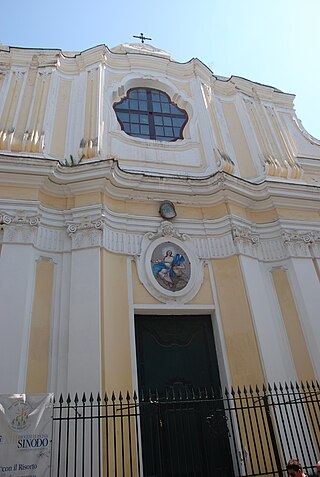
The Diocese of Ischia is a Latin diocese of the Catholic Church in Campania, southern Italy. It is a suffragan of the Archdiocese of Naples. The diocese comprises the entire island of Ischia, which contains seven communes divided into two circumscriptions. In 1743, the population was about 4,000. The city of Ischia constituted one single parish, with two religious houses of men and one of women. In 2018, the population of the town of Ischia was 20,118.

The Diocese of Pozzuoli is a Latin diocese of the Catholic Church in Campania, southern Italy. It is a suffragan of the Metropolitan Roman Catholic Archdiocese of Naples, like its other neighboring dioceses, Aversa and Ischia.
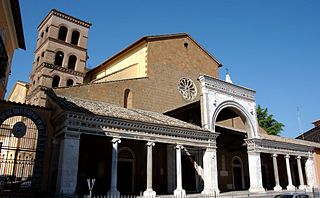
The Diocese of Civita Castellana is a Latin Church ecclesiastical territory or diocese of the Catholic Church in Latium, central Italy. It has existed in the current form since 1986, when the Diocese of Nepi e Sutri was united into the Diocese of Civita Castellana, Orte e Gallese. The Diocese of Gallese had been added to the Dioceses of Civita Castellana and Orte in 1805. The name of the diocese was shortened in 1991, in accordance with Vatican policies. The diocese of Civita Castellana is immediately exempt to the Holy See.
The Italian Catholic diocese of Lacedonia, a suffragan of the archdiocese of Benevento in Campania, existed until 1986 when incorporated into the reorganized Roman Catholic Diocese of Ariano Irpino-Lacedonia.
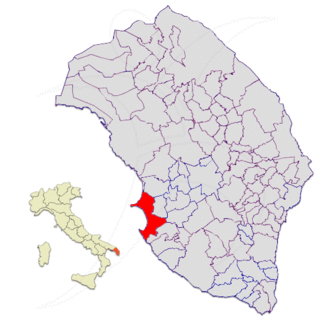
The Diocese of Gallipoli was a Roman Catholic ecclesiastical territory in the province of Apulia in southern Italy. It was erected in the 6th century. On September 30, 1986, the diocese was suppressed, and its territory merged into the Diocese of Nardò-Gallipoli.

The Diocese of Guardialfiera or Diocese of Guardia was a Roman Catholic diocese in Italy. The diocese was established in the second half of the 11th century, with seat of the diocese was located in the city of Guardialfiera in the Province of Campobasso in the region of Molise. In 1818, the diocese was suppressed, and its ecclesiastical territory was assigned to the Diocese of Termoli.
The Diocese of Comacchio was a Roman Catholic diocese located in the coastal town of Comacchio in the province of Ferrara and region of Emilia Romagna, Italy. In 1986, the diocese of Commachio was united with the diocese of Ferrara to form the Roman Catholic Archdiocese of Ferrara-Comacchio, and lost its individual identity.